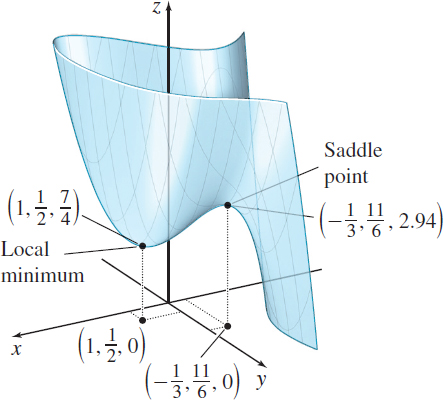EXAMPLE 4Using the Second Partial Derivative Test
Find all local maxima, local minima, and saddle points for z=f(x,y)=x3+y2+2xy−4x−3y+5
Solution The critical points are the solutions of the system of equations {fx(x,y)=3x2+2y−4=0fy(x,y)=2y+2x−3=0
We solve the system using substitution. Solving for y in fy(x,y)=0, we obtain y=12(3−2x). Then if we substitute for y in fx(x,y)=0, the result is 3x2+2[12(3−2x)]−4=03x2−2x−1=0(3x+1)(x−1)=0x=−13or x=1
883
When x=−13, then y=12(3−2x)=12(3+23)=116.
When x=1, then y=12(3−2x)=12.
The critical points are (−13,116) and (1,12).
The second-order partial derivatives of f are fxx(x,y)=6xfxy(x,y)=2fyy(x,y)=2

The function f satisfies the requirements of the Second Partial Derivative test at each critical point. At (−13,116), A=fxx(−13,116)=−2B=fxy(−13,116)=2C=fyy(−13,116)=2AC−B2=−4−4=−8<0
So, (−13,116,317108) is a saddle point of f. At (1,12), A=fxx(1,12)=6B=fxy(1,12)=2C=fyy(1,12)=2
Since AC−B2=8>0, f has a local minimum at (1,12), where f(1,12)=74